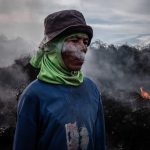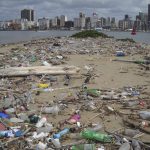Book Review | A Billion Black Anthropocenes or None
Kathryn Yusoff’s A Billion Black Anthropocenes or None locates the origins of climate change in slavery while exploring the grammars of capture, extraction and displacement.
Author:
28 August 2019

1452: Pope Nicholas V issues a papal bull (official document) known as Dum Diversas, bestowing upon Afonso V – the 10th King of Portugal – the authority to conquer territories in North Africa and consign peoples found there to “perpetual servitude”. Known especially for his conquests in Morocco, this date also marks the earliest time when African people were forcefully removed from their homeland and made to work as slaves on the first plantations on Madeira, the Portuguese island.
1784: James Watt invents the steam engine, an invention said to have driven the industrial revolution.
1980: The ecologist Eugene F Stoermer coins the term “Anthropocene”.
2000: Dutch Nobel Prize-winning atmospheric chemist Paul Jozef Crutzen proposes a new geological epoch to describe the “global effects of human activities”. Relying on Stoermer’s concept, Crutzen popularises the term “Anthropocene” to explain how the spike in so-called “greenhouse gases” has given rise to climate change and other atmospheric disturbances. He links this spike to Watt’s invention.
2015: A year marking the beginning of what is known as the “European migrant crisis”. Sparked by poverty, drought and war, this year sees the large-scale migration of people from Africa and the Middle East to Europe. By the end of 2016, the number of refugees will have reached 65.6 million. Thousands of migrant deaths have and continue to be recorded each year.
2019: Two problems persist, that of place or geography and that of the place of the human or subjectivity.
Current day
A Billion Black Anthropocenes or None could be summed up as a new history of the relationship between geology and subjectivity. This is by no means a novel concern – pre-black conscious writers such as WEB du Bois, black conscious writers including Frantz Fanon and Steve Biko, and their contemporaries and successors, for example Sylvia Wynter, Achille Mbembe and Kathrine McKittrick, have all grappled with the complex human-citizenship-land question.
What makes Kathryn Yusoff’s book different is that it addresses these questions via contemporary concerns about the Anthropocene, the name given to the new geological epoch. Unlike previous epochs, such as the Pleistocene, which was marked by climatological planetary impacts – in this case repeated glaciations, which is why it’s also called the Ice Age – the Anthropocene is marked by human interference.
Of particular concern are the effects that activities such as deforestation, mining, road-building, dam-building and landfills have had on the earth’s lithosphere, crust and upper mantle. As these activities produce fossil fuels and use materials like plastics, there have been unprecedented fluxes in climate and ocean pollution, which have caused the ongoing mass extinction of organisms and ecosystems.
Related article:
The main argument Yusoff makes in her book is that the formulation of the Anthropocene contains a racial blindness that fails to take into account three important aspects. The first is the histories of slavery and its associated forced displacement. The second is the justification of slavery by means of the invention of race. These two aspects form the two pincers of what Yusoff calls a double dispossession – spatial dispossession, which includes issues of place, space and land; and the “dispossession of persons in chattel slavery”, which includes aspects such as citizenship and the “biopolitical category of nonbeing” (the inhuman or subhuman).
The third aspect not accounted for in the current formulation of the Anthropocene is the ongoing effects this double dispossession has on black lives as seen, for example, in the so-called migration “problem”.
The mystification of these three aspects is achieved by deference to scientific social discourse: naming the Anthropocene a geological epoch hides the fact that it had its origins in slavery rather than in the invention of the steam engine and its affiliated acceleration in the production of greenhouse gases.
In other words, recourse to geology allows whiteness to go unchallenged because it fails to acknowledge the dispossessing practices of subject-making in the history of what is now named the Anthropocene. As Du Bois put it, whiteness can be defined as “ownership of the Earth for ever and ever”.
The missing parts
One of the main aspects unaccounted for in the Anthropocene narrative is violence, not only physical violence but also the violence of “nonbeing”, that is, exclusion from the category “human”. These violences often remain hidden beneath discourse centred on the nation-state, belonging and exclusion, and property – what we might refer to as three “grammars”: grammars of capture (following American literary critic Hortense Spillers), grammars of extraction and grammars of displacement.
Grammars of capture refer to origin stories that produce mythic accounts of slavery. According to these accounts, there was no invention of man nor of whiteness. Like Wynter before her, Yusoff argues that such grammars of capture are typical of “Western” or “white” logic, and that it should be uncovered for what they are. In other words, they should be understood first in terms of the “invention of the figure of Man in 1492 as the Portuguese travel to the Americas” and, second, as “a refiguring of humanness” in which whiteness is seen as superior to blackness. Uncovering these two false notions is, for her, part of the grammars of dissent: refusal of the codes that colonialism bestowed upon certain people and certain places.
Whereas grammars of capture refer to the displacement of peoples, grammars of extraction refer to the hidden labour of slavery. We may think here, for example, of plantations and mines where people of colour have and continue to be exposed to extractive waste, both on the Earth and underneath it. These are named cotton and sugar plantations, they are named Marikana, but never are they named Anthropocene.
Here lies one of the most powerful arguments Yusoff makes: Anthropocene is understood in the future tense rather than in terms of the extinctions already undergone “by black and indigenous peoples”, and this precisely is what she calls “a billion black Anthropocenes”.
From slave to migrant
Besides capture and extraction, colonialism, and by extension whiteness, also relies on what can be called grammars of displacement, first marked by the forced relocations of slavery. The justification of displacement relies on a powerful construction that equates people to property and extracts from that property certain properties.
As Yusoff explains: “The instigation of slavery was prompted by a recognition of the so-called properties of African physiology, where indigenous Indians were viewed as not robust enough for mining and plantation work.” Both the slave and the mineral (mines) or plant (plantation) therefore became important for their extraction value. Here we come full circle in the argument that shows how geology positions racial identity in history.
In the same way that geology positions racial identity, the lack of geological placement positions the migrant. Stripped of land – whether because of climate change (drought), war or poverty – the asylum seeker becomes nameless, referenced only as the migrant or the refugee. Two problems persist, that of place (geography) and that of the place of the human (subjectivity).
Interestingly, this allows “Europe” once more to enact a colonisation but, instead of actively displacing people through forcible removal, “they” passively displace people through methods of exclusion. The (non) properties of the migrant are deemed worthless in terms of their extraction value so that geology in this instance “becomes a spacing in the imagination that is used to separate forms of the human into permissible modes of exchange and circulation” from which the migrant is excluded.
Related article:
The refugee “problem” is, however, not only a European one. “As a whole, African countries hosted 24.7 million immigrants in 2017, up from 19.3 million in 1990; a 28% increase. Almost all of these immigrants were born somewhere in Africa. And conditions are ripe for this to continue.”
Despite the positive picture that the phrase “hosting immigrants” paints, xenophobia is as rife in Africa as elsewhere. Headlines such as “Immigration: State to crack down” continue to produce mythic versions of the inherent “goodness” of nation-states but, as Yusoff reminds readers, “nation-states are configurations of origins as exclusionary power structures which have legitimacy based solely on conquest and acquisition.”
To put it differently, the notion of “the nation” is predicated on histories of slavery, themselves reliant on histories of dispossession, both of land and subjectivity. Tighter border controls and “clamping down” often signify little more than a re-enactment of the biopolitical enslavement of nonbeing first enacted by settler colonialism and whiteness. Besides, in the Anthropocene, everyone is a migrant in the making.
Insurgent geology
The question, quite literally, is: how will we weather the storm?
In her final chapters, Yusoff speaks “to the traffic between the categories of the inhuman in the white geology of transatlantic slavery and in its Anthropocenic present”, to which must be added the traffic of asylum seekers – the nonhumans (or inhuman) of our time. Following Wynter, she draws on the term “transplantation” to follow the alternative histories of black bodies and map the ways in which they reclaimed the right to geography within the confined spaces of plantations, mines and other similar places.
Drawing on accounts of the blues, the dissent of miners and slave uprisings, Yusoff sketches a piercing line from the commodification of the black body, through the capture and captivity of black bodies, to futurity. “It is the power to imagine beyond current fact and to envision that which is not, but must be,” feminist scholar Tina Campt puts it.
Fragments of the future
2030: The Mexican Wall is built. A number of European countries have followed suit. Northern China is the only place left to go, but there are risks. Different risks. Now almost entirely desert, many more refugees from Spain, Portugal, Italy, Greece, Turkey, North Africa’s coast, Namibia, Botswana, South Africa and the southwestern region of Australia sail the seas. Hundreds of thousands of migrant deaths continue to be recorded each year.
Alaska, parts of the North and South Poles, and Canada have washed away. Floods have increased significantly. Implemented measures are only partially successful.
Every Anthropocene is a black one. “No geology is neutral.”
2030 (alternative ending): A light goes on in the dark. Most cities are dark now, but for the solar power, used sparingly. My grandmother sits next to my bed, opening the book where we last read from Octavia Butler’s Bloodchild and Other Stories: “Positive obsession,” she reads, “is about not being able to stop just because you’re afraid and full of doubts. Positive obsession is dangerous. It’s about not being able to stop at all.”
Kathryn Yusoff’s A Billion Black Anthropocenes or None (2018, University of Minnesota Press) was released as part of the Forerunners Series. It is available to read for free online.


